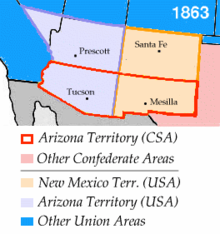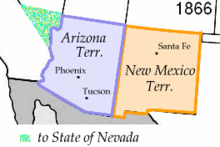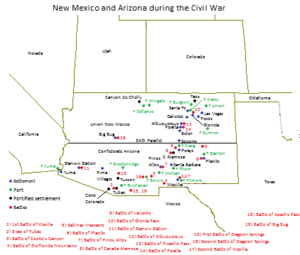- New Mexico Territory in the American Civil War
-

Union States
in the
American Civil WarCalifornia
Connecticut
Illinois
Indiana
Iowa
Kansas
Maine
Massachusetts
Michigan
Minnesota
Nevada
New Hampshire
New Jersey
New York
Ohio
Oregon
Pennsylvania
Rhode Island
Vermont
WisconsinBorder states Delaware
Maryland
West VirginiaDual governments Territories Arizona
Colorado
Dakota
Idaho
Montana
Nebraska
New Mexico
Utah
WashingtonConfederate States
in the
American Civil WarSouth Carolina
Mississippi
Florida
Alabama
Georgia
Louisiana
Texas
Virginia
Arkansas
North Carolina
TennesseeDual governments Border states Delaware
Maryland
West VirginiaTerritories The New Mexico Territory, which included the areas which became the modern U.S. states of New Mexico and Arizona as well as the southern part of Nevada, played a role in the Trans-Mississippi Theater of the American Civil War. Both Confederate and Union governments claimed ownership and territorial rights over it. In 1861 the Confederacy claimed the southern tract as its own Arizona Territory and waged the ambitious New Mexico Campaign in an attempt to control the American Southwest and open up access to Union California. Confederate power in the New Mexico Territory was effectively broken after the Battle of Glorieta Pass in 1862. However, the territorial government continued to operate out of Texas, and Confederate troops marched under the Arizona flag until the end of the war. Additionally, over 8,000 troops from New Mexico Territory served the Union.[1]
Contents
Prelude to war
After the expansion of the New Mexico Territory in 1853 by the Gadsden Purchase, proposals for a division of the territory and the organization of a separate Territory of Arizona in the southern half of the territory were advanced as early as 1856. The first proposals for the Arizona Territory were not based on the current east-west scheme, but rather a north-south division. The proposals arose from concerns about the effectiveness of the territorial government in Santa Fe to administer the newly-acquired southern portions of the territory.[2]
The first proposal dates from a conference held in Tucson that convened on August 29, 1856. The conference issued a petition to the U.S. Congress, signed by 256 people, requesting organization of the territory and elected Nathan P. Cooke as the territorial delegate to Congress. In January 1857, the bill for the organization of the territory was introduced into the United States House of Representatives, but the proposal was defeated on the grounds that the population of the proposed territory was yet too small. Later a similar proposal was defeated in the Senate. The proposal for creation of the territory was controversial in part because of the perception that the New Mexico Territory was under the influence of southern sympathizers who were highly desirous of expanding slavery into the southwest.
In February 1858, the New Mexico territorial legislature adopted a resolution in favor of the creation of the Arizona territory, but with a north-south border along the 109th meridian, with the additional stipulation that all the Indians of New Mexico would be removed to northern Arizona.[3] In April 1860, impatient for Congress to act, a convention of thirty-one delegates met in Tucson and adopted a constitution for a provisional territorial government of the area south of 34 degrees north. The delegates elected Lewis Owings as provisional governor.
However, due to the small number of inhabitants in the proposed territory, the U.S. Congress continued to refuse to recognize any proceedings from any of the conventions being held in this area. Additionally, making matters worse, on March 2 of 1861 the U.S. Government formally revoked a contract with the Butterfield Overland Stagecoach Company which was being used to support delivery of United States mail on the overland route which ran from San Antonio, Texas through El Paso, Texas, Mesilla, Tucson and on to California. The loss of this key communications link with the rest of the United States angered the settlers in the Arizona region, just as the deep South states were seceding from the Union.
Civil War
Politics
At the outbreak of the Civil War, sentiment in the territory was in favor of the Confederacy. A territorial secession convention was held at Mesilla on March 16, 1861 that adopted an ordinance of secession, and called on the citizens in western Arizona to "join us in this movement". Subsequently a second convention was held in Tucson on March 28, 1861, chaired by Mark Aldrich, who had been Tucson's first mayor. The Tucson convention ratified the Mesilla convention, and provisional officers were elected for the newly established Provisional Confederate Territory of Arizona with Dr. Lewis Owings as its governor, and Granville H. Oury as its first delegate to the Confederate States Congress, who immediately began petitioning for admission.
Early in war, the Confederacy regarded the territory as a valuable route for possible access to the Pacific Ocean, with the specific intention of capturing California. In July 1861, a small Confederate force of Texans, under the command of Lieutenant Colonel John R. Baylor, captured Mesilla in the eastern part of the territory. After the fort was abandoned by the Union garrison, Baylor's force cut off the fleeing Union troops and forced them to surrender. On August 1, Baylor issued a "The Proclamation to the People of the Territory of Arizona", taking possession of the territory for the Confederacy, with Mesilla as the capital and himself as the governor.[4]
"The social and political condition of Arizona being little short of general anarchy, and the people being literally destitute of law, order, and protection, the said Territory, from the date hereof, is hereby declared temporarily organized as a military government until such time as Congress may otherwise provide. I, John R. Baylor, lieutenant-colonel, commanding the Confederate Army in the Territory of Arizona, hereby take possession of said Territory in the name and behalf of the Confederate States of America. For all purposes herein specified, and until otherwise decreed or provided, the Territory of Arizona shall comprise all that portion of New Mexico lying south of the thirty-fourth parallel of north latitude."
— LtCol. John R. Baylor, CSA[5]
Baylor's subsequent dismantling of the existing Union forts in the territory left the white settlers at the mercy of the Apache, who quickly gained control of the area and forced many of the white settlers to seek refuge in Tucson. However, the people of Arizona remained firm in their support of Baylor, and held another convention on August 28, 1861 in Tucson, ratifying Baylor's proclamation. Once again, Granville Oury was re-elected as a congressman to the Confederate States Congress. Governor Baylor approved the proceedings, and Delegate Granville H. Oury was sent off to Richmond, Virginia on October 1, 1861.[6]
Delegate Oury was not initially seated in the congress, but met with C.S. leaders as well as President Jefferson Davis. Texas Congressman John Reagan introduced a bill on November 22, 1861 to formally create the Territory of Arizona. After two months of debate, the legislation passed on January 13, 1862, and the territory was officially created by proclamation of President Jefferson Davis on February 14, with this proclamation:
"I, Jefferson Davis, President of the Confederate States of America, do issue this, my proclamation, declaring said "Act to organize the Territory of Arizona" to be in full force and operation, and that I have proceeded to appoint the officers therein provided to be appointed in and for said Territory."
— President Jefferson Davis[7]
Exactly fifty years later, on the same date, Arizona was made a state in 1912.
The following month, in March 1862, the U.S. House of Representatives, now devoid of the southern delegates and controlled by Republicans, passed a bill to create the United States Arizona Territory using the north-south border of the 107th meridian. The use of a north-south border rather than an east-west one had the effect of denying a de facto ratification of the Confederate Arizona Territory. The house bill stipulated that Tucson was to be capital. It also stipulated that slavery was to be abolished in the new territory. The Arizona Organic Act passed the Senate in February 1863 without the Tucson-as-capital stipulation, and was signed into law by President Abraham Lincoln on February 24, the date of the official organization of the US Arizona Territory. The first capital was at Fort Whipple, followed by Prescott, in the northern Union-controlled area.[8]
At the start of the Civil War, the territorial governor was Abraham Rencher; although a Democrat from North Carolina, he refused to support succession, and called out the territorial militia to counteract the Confederate invasion of July 1861. That month he was replaced by Henry Connelly, a native of New Mexico who would serve as governor for the remainder of the war. Under his leadership, the slavery laws of the territory were repealed and the Indian tribes of the territory were moved onto reservations.[9]
Military actions
When Federal troops left Arizona early in 1861, the territory was left open to Apache attack. Mangas Coloradas and Cochise led a series of raids on white civilians that left dozens dead and spread fear and terror across the territory. Both the Confederates and the Federal government attempted to control the Apaches. The remaining Union troops in the New Mexico Territory were concentrated in forts along and near the Rio Grande; the commander of the Union Department of New Mexico, Colonel E. R. S. Canby, started raising regiments of New Mexico volunteers and militia to replace the regular army units which were ordered east.[10]
Capt. Sherod Hunter at the head of the Confederate Arizona Rangers, occupied southern Arizona during the spring of 1862. He bore orders from Governor Baylor to lure the Apaches into Tucson for peace talks and exterminate the adults. Hunter's frontiersmen spent most of their time expelling Union supporters and skirmishing with Federal troops, so the order was never enforced. A detachment of Hunter's force traveled along the Overland Mail route and destroyed chaches of hay to prevent their use by Union forces; it traveled to within eighty miles of Fort Yuma.[11]
In April 1862, a small party of Confederates moving northwest from Tucson met a Union cavalry patrol near Stanwix Station. The skirmish that followed, in which one Union cavalryman was wounded, was the westernmost engagement of the Civil War. The goal of expanding Confederate influence into southern California and to the Pacific Ocean was never realized. Following the Battle of Picacho Pass at Picacho Peak the lead detachment of Col. James H. Carleton's California Column, drove the Confederates out of Tucson, and advanced on the Mesilla the capital of Confederate Arizona and by July the Confederates had retreated to Texas. Carleton's troops later fought the Battle of Apache Pass after being ambushed by Cochise and Mangas Coloradas. Even though the column withstood the Apaches and established Fort Bowie to secure the pass, the Californians and the Apache would continue fighting throughout the War and beyond.[12]
As the main route to California, the New Mexico Territory was disputed territory during the American Civil War, resulting in settlers in the region carved out by the Gadsden Purchase willingly joining the Confederate States of America, while much of the rest of the present day state of New Mexico remained loyal to the Union. A significant Confederate push to seize the territory resulted in the New Mexico Campaign from February to April 1862. Confederate troops from Texas briefly occupied southern New Mexico Territory. Union troops re-captured the territory in early 1862. As the war lengthened and Union troops were withdrawn to fight elsewhere, famed explorer and frontiersman Kit Carson helped organize and command the 1st New Mexico Infantry, a militia unit, to engage in campaigns against the Apache, Navajo, and Comanche in New Mexico and Texas, as well as participating in the earlier Battle of Valverde against the Confederates. Confederate troops withdrew after the Battle of Glorieta Pass, because a detachment of the 1st Colorado Infantry under Major John M. Chivington had burned their supply train. Despite the Union regulars, 1st Colorado Infantry ("The Pikes Peakers"), and New Mexican Volunteers being defeated on the battlefield, they won the campaign; the battle was later dubbed as the "Gettysburg of the West".
Confederate Arizona Territory, which split off from New Mexico Territory in 1861, was the first U.S. incarnation of Arizona which would come into existence as Arizona Territory in 1863. Confederate Arizona was created by capturing the southern tier of the Union's New Mexico Territory, while the boundary established in 1863 created an Arizona on the west separated from New Mexico on the east.
See also
- Independent Companies, New Mexico Volunteer Militia Infantry
- List of New Mexico Territory Civil War units
Notes
- ^ http://www.civilwardata.com/dbstatus.html
- ^ Colton, p. 198.
- ^ Colton, p. 198.
- ^ Colton, p. 198–200.
- ^ Branigan Cultural Center
- ^ Frazier, pp. 62, 115.
- ^ Sons of Confederate Veterans, Arizona Chapter.
- ^ Colton, pp. 202–203.
- ^ Colton, pp. 191–197.
- ^ Frazier, pp. 54–56.
- ^ Frazier, pp. 132, 206–207.
- ^ Frazier, pp. 207, 258.
References
- Cheek, Lawrence W. Arizona. Oakland, CA: Compass American Guides, 1995. ISBN 1-878867-72-5
- Colton, Ray C. The Civil War in the Western Territories: Arizona, Colorado, New Mexico, and Utah. Norman, Oklahoma: University of Oklahoma Press, 1959.
- Frazier, Donald. Blood & Treasure: Confederate Empire in the Southwest. College Station, Texas: Texas A&M University Press, 1995. ISBN 0-89096-639-7.
- Kerby, Robert Lee, The Confederate Invasion of New Mexico and Arizona, Westernlore Press, 1958. ISBN 0-87026-055-3
- Masich, Andrew E. The Civil War in Arizona; the Story of the California Volunteers, 1861-65. Norman: University of Oklahoma Press, 2006.
- Sheridan, Thomas E. Arizona: A History. Tucson, AZ: The University of Arizona Press, 1995. ISBN 0-8165-1515-8
External links
American Civil War (outline) Origins - Combatants
- Theaters
- Campaigns
- Battles
- States
CombatantsTheatersMajor battles- Fort Sumter
- 1st Bull Run
- Wilson's Creek
- Fort Donelson
- Pea Ridge
- Hampton Roads
- Shiloh
- New Orleans
- Corinth
- Seven Pines
- Seven Days
- 2nd Bull Run
- Antietam
- Perryville
- Fredericksburg
- Stones River
- Chancellorsville
- Gettysburg
- Vicksburg
- Chickamauga
- Chattanooga
- Wilderness
- Spotsylvania
- Cold Harbor
- Atlanta
- Mobile Bay
- Franklin
- Nashville
- Five Forks
Involvement
by state or territoryLeaders ConfederateMilitaryCivilianUnionMilitaryCivilianAftermath - Alabama Claims
- Carpetbaggers
- Freedman's Bank
- Freedmen's Bureau
- Jim Crow laws
- Redeemers
- Southern Claims Commission
Cemeteries- Confederate memorials and cemeteries
- National cemeteries
- U.S. memorials and cemeteries
VeternsOther topics- Related topics
- Categories
Related topicsMilitaryPoliticalOther topicsCategories- American Civil War
- People
- Battles
- Union Army generals
- Union armies
- Union Army corps
- Confederate States of America (CSA)
- Confederate Army generals
- Confederate armies
- Spies
- National Battlefields
- Veterans' organizations
- Medicine
- Museums
- Forts
- Old soldiers' homes
- Prisons
- Reconstruction
- U.S. memorials and cemeteries
- Confederate memorials and cemeteries
American Civil War at sister projects  American Civil War portal
American Civil War portal Military History: American Civil War
Military History: American Civil War Special Project: Brothers at War
Special Project: Brothers at War
Wikimedia Foundation. 2010.




